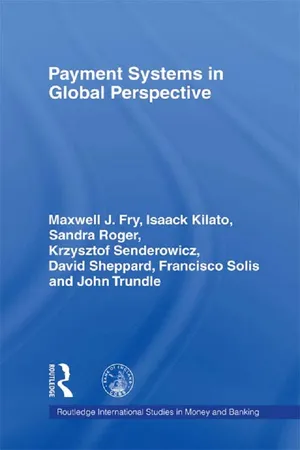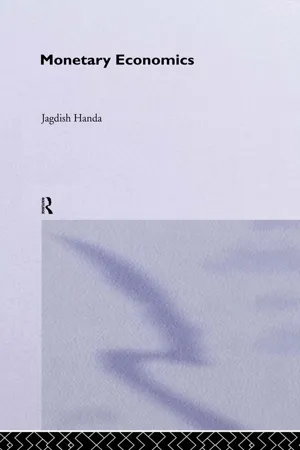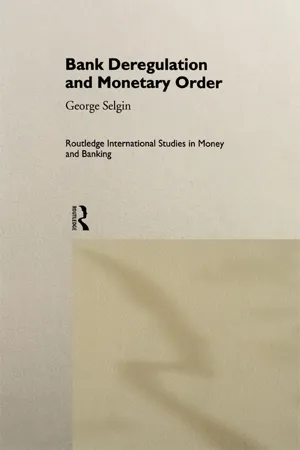Economics
Reserve Requirements
Reserve requirements refer to the amount of funds that banks are required to hold in reserve, typically as a percentage of their deposits. These requirements are set by central banks and are used to control the amount of money in circulation and influence economic activity. By adjusting reserve requirements, central banks can impact the lending capacity of commercial banks and ultimately the overall money supply in the economy.
Written by Perlego with AI-assistance
Related key terms
7 Key excerpts on "Reserve Requirements"
- eBook - ePub
- Maxwell J. Fry(Author)
- 2012(Publication Date)
- Routledge(Publisher)
Chapter 5Reserve Requirements, Liquidity and Risk
5.1Introduction
IN RECENT YEARS, REQUIRED RESERVES have been reduced or eliminated in many countries, particularly transitional economies, to remove resource allocation distortions and to counteract financial disintermediation. For example, the ratio of bank reserves to bank deposits fell from over 50 percent to under 20 percent in Estonia, 1991–1996, from 25 to 15 percent in Lithuania, 1993–1995, from 35 to 10 percent in Poland, 1988–1996, from 26 to 18 percent in Russia, 1993–1996, and from 80 to 18 percent in the Ukraine, 1992–1997 (International Financial Statistics, CD-ROM, March 1997).To the extent that required reserves can be used during the day for payment purposes, they provide a costless source of liquidity. But noninterest-earning required reserves impose negative effective protection on a country's financial system so encouraging residents to use cheaper financial intermediation services abroad. International competition is therefore forcing monetary authorities to reduce the burden of Reserve Requirements either by lowering ratios or by paying interest on such reserves. At the same time, RTGS systems have been introduced in many industrial, transitional and developing countries both to eliminate settlement risk from high-value payment systems and to reduce moral hazard.These two tendencies create potential friction: the former diminishes demand for reserves to be kept overnight and the latter increases demand for reserves during the day. This conflict may encourage banks to spend too much effort from the social welfare viewpoint in managing their reserves. This chapter describes and discusses ways of dealing with these opposing forces, particularly as they apply to transitional and developing countries. - eBook - ePub
The European Monetary Union
A Commentary on the Legal Foundations
- Helmut Siekmann, Helmut Siekmann(Authors)
- 2021(Publication Date)
- Hart Publishing(Publisher)
93 The Bundesbank Act in the version valid until the end of 1998 contained rules regarding minimum Reserve Requirements and can be seen as an inspiration for comparable rules contained in Article 19.10 Besides the Deutsche Bundesbank, a number of other central banks of Member States of the Union,11 as well as the Federal Reserve12 and the Bank of Japan,13 used or use minimum Reserve Requirements as a standard monetary policy instrument.144 Article 19.1 (not the competences of the Council pursuant to Article 19.2) can be amended by the simplified amendment procedure according to Article 129.3 TFEU (Article 40.1 Statute).B. General SignificanceI. Objectives and Relevance of Minimum Reserve Requirements5 Minimum Reserve Requirements are a standard Eurosystem monetary policy tool for the performance of money market management and monetary control functions.15 They aim at stabilising money market interest rates and creating or enlarging a structural liquidity shortage (structural deficit of central bank liquidity).16 By giving institutions an incentive to smooth the effects of temporary liquidity fluctuations, the “average principle”17 of the Eurosystem minimum reserve system supports the stabilisation of money market interest rates.18 The “average principle” also prevents a strong volatility of the overnight rate as it enables institutions to satisfy short-term demands on central bank liquidity with their minimum reserve holdings.19 Minimum Reserve Requirements also ensure the dependency of credit institutions on central bank refinancing operations by increasing the demand for central bank liquidity.20 This demand facilitates the conduction of monetary policy, e.g. to steer money market rates through regular liquidity-providing operations.21 An intended side effect is the increase of the institutions’ liquidity (and solvency) by means of their reserve holdings, even though the banking supervisory law provides increasingly detailed requirements on the institutions’ liquidity ratios.22 - eBook - ePub
- Leonard Jay Santow(Author)
- 2016(Publication Date)
- Routledge(Publisher)
4 Experience with Reserve Requirements Since World War IIIn this chapter I present the history of reserve requirement regulations as far back as 1948 so as to include the many meaningful changes that occurred shortly after the end of World War II. In 1948 the reserve requirement specifications were applied differently, depending on how the Fed characterized a particular group of banks. However, the requirements themselves were relatively simple. Over the more than four decades that followed, the requirements became more complex and subject to a great many changes. In the 1990s the series of changes have brought us to the point where the requirement regulations would not be very effective in preventing banks from becoming overly aggressive in liability management. This may be satisfactory for a time, but limitations on banks' aggression may be necessary before the 1990s are out. Therefore, I continue by describing what is necessary to make the reserve requirement system an effective policy tool for the remainder of this decade. I discuss some questionable recommendations for changes in the system, together with the problems that would be created if the changes were adopted.A History of Reserve Requirements: 1948 to the Present
Reserve Requirements are regulatory methods that can be used to limit or enhance bank credit expansion. By consulting Table 4.1 , showing Reserve Requirements, and Table 4.2 , illustrating the minimum and maximum percentages allowed on required reserves, the reader can get a graphic view of more than forty years of reserve requirement history.By the end of 1948, reserve requirement percentages, especially on demand accounts, were near the ceilings allowed. Banks were divided into three requirement categories, based on location and size—central reserve city, reserve city, and country. For the largest banks (central reserve city), the Reserve Requirements on demand accounts were 26 percent; for large banks, primarily regional (reserve city), the requirement was 22 percent; and for country banks, 16 percent. All these banks operated under a reserve requirement on time deposits of 7.5 percent. The dollar amount of requirements, especially on demand accounts, was very high relative to the dollar amount of outstanding bank credit. The primary reason for the high requirements was that, supposedly to combat inflation, the Fed wanted to absorb huge excess reserves created in the 1930s. This inflation fear was evident in the legislation that was passed in 1948. - eBook - ePub
- Indranarain Ramlall(Author)
- 2018(Publication Date)
- Emerald Publishing Limited(Publisher)
Liquidity reserves fall into the liquidity coverage ratio and the net stable funding ratio under Basel III. The liquidity coverage ratio is expected to be 100% in normal times and allowed to decline during difficult economic conditions. The liquidity coverage ratio captures a bank’s stock of high quality liquid assets over its net cash outflows over the next thirty days and thereby reflects a short-term metric for liquidity position of a bank. The net stable funding ratio is also assumed to be 100% during normal times but captures the long-term liquidity position of a bank as it calculates the proportion of long-term assets which are funded by long-term stable funding. Stable sources of funding can be split into Tier 1 capital, Tier 2 capital, other preferred shares and short-term liabilities such as demand deposits.Banks hold not only liquid and capital reserves but they are also obliged by their respective central banks to keep required reserves at the central banks. These reserves can be deemed to form part of liquidity reserves as they are meant to protect the banking sector from declines in liquidity. Some central banks remunerate these reserves while others do not. Interestingly, not all central banks impose Reserve Requirements. Moreover, some banks may keep reserves beyond the stipulated amount at central banks, known as excess reserves. Reserve Requirements are deemed better than interest rate to influence the level of economic activities in an economy. For example, a contractionary monetary policy elicits increases in both deposit and borrowing rates which contribute towards reduced economic activities but at the expense of higher capital inflows attracted by the higher interest rates. These high interest rates can be damaging to an economy which adheres to a fixed exchange rate regime. Reserve Requirements directly help to curtail economic activities without triggering any undesired excessive capital inflows into the economy.While both capital reserves and liquidity reserves are of paramount significance to a bank, yet, key differences prevail between them. Capital reserves tend to be more of a long-term nature with the primary aim of averting insolvency of a bank so that the bank can work smoothly even during difficult economic conditions. It can therefore be conjectured that capital reserves are critically important for a bank to mitigate the amplitude of the downward trend of the credit cycle during crisis conditions. Liquidity reserves, though consist of both a long-term and a short-term metrics (net stable funding ratio and liquidity coverage ratio, respectively), tend to be more tilted towards the day-to-day activities of the bank as it sieves out the extent to which assets can be converted into cash. In a nutshell, it can be said that capital reserves ensure the long-term survival of the bank while liquidity reserves ensure the short-term viability state of the bank, making capital reserves and liquidity reserves as complementary tools for financial stability in the banking sector. To bolster financial stability, banks should hold countercyclical assets such as gold whose value scales up during a downturn or a recession and declines during economic booms. - eBook - ePub
Keeping The Central Bank Central
U.S. Monetary Policy And The Banking System
- Weir B Brown(Author)
- 2019(Publication Date)
- Routledge(Publisher)
What is important to recognize is that altering the structure and coverage of the central bank's reserve instrument is an economic policy question to be decided on the basis of whether that would preserve the effectiveness of the Fed's monetary control policy. The matter of the level and distribution of the Reserve Systems' operating profits is not pertinent to that macroeconomic policy question. In stating that the estimated decrease in Treasury receipts was "an 'acceptable' price to pay for being able to deal with the monetary control problem," the Secretary of the Treasury was in effect conceding both the separateness of the two subjects and the superior importance of the monetary policy subject. In addition, the Secretary spoke against the notion that was incorporated in the final MCA of exempting important deposit categories from Reserve Requirements, noting that, in the absence of comprehensive reserve coverage of deposits, "uncontrollable shifts of funds from reservable deposits to non-reservable ones act to weaken the linkage between the reserve base and the money supply." 20 In deciding to revise the structure of Reserve Requirements along the lines described, including the exemption of the bulk of time deposit accounts and certificates, the legislative and monetary authorities appear to have given inadequate attention to developments in the operational behavior of the banking industry and its depositors and to the wider implications of such changes. The Federal Reserve's policy objective of influencing monetary and credit conditions in the U.S. economy is effectuated principally through the banking system - eBook - ePub
- Jagdish Handa(Author)
- 2002(Publication Date)
- Routledge(Publisher)
B is exogenously given.A simple form of the money supply function, say for M1, which takes the demand for currency, time deposits and bank reserves as given, specified in a linear form on this basis would be:where the coefficientsmi , i= 2,…,4, are the relevant multipliers, measuring the impact of changes in the explanatory variables on the supply of M1 and are likely to differ in value. Equation (21) is a behavioural equation since its multipliers are determined by the data generated by the behaviour of the agents in the economy.Equation (21) is a very simple form of the money supply equation in the behavioural approach. In countries where there are differential Reserve Requirements, varying either by types of deposits or types of financial institutions, account has to be taken of shifts of deposits among these categories. One way of doing this is to replace the monetary base term B by a modified term that specifies the ‘effective’ amount of the monetary base. An alternative would be to incorporate the various Reserve Requirements as explanatory variables on the right-hand side of (21 ).Terms m 2 C 0 , m 3 T 0 and m 4 R 0 in (21) represent the influence of economic factors other than those operating through m 1 and B . These terms in turn depend upon other economic variables, as discussed earlier. The government’s demand deposits are not considered in equation (21) - eBook - ePub
- George Selgin(Author)
- 2002(Publication Date)
- Routledge(Publisher)
Calomiris and Kahn (1991) and others.Effects of Legal Restrictions
Statutory Reserve Requirements
Statutory Reserve Requirements and the prohibition of private banknotes are two reasons why real world banking systems do not function like a free banking system. The model is easily modified to show the consequences of a statutory reserve requirement by rewriting (2) as(2')R = ( 1 − p ) σ bq+π M ,where 0 < p < 1 is the minimum legal ratio of reserves-to-bank-issued money. Equation (2') shows total reserve demand to be the sum of net precautionary and legal requirements. Solving for M givesM *=RV q ( 1 − π )+[]ϕ y2 ( b − 1 )1 2R π,which shows that velocity-induced adjustments in the money stock are more limited than in the free banking case. Consider, for example, a situation where the stock of base money is frozen and velocity is declining. Under free banking the money stock could, as we have seen, grow in response to a fall in velocity sufficiently to prevent any contraction of aggregate money income. If a statutory reserve requirement is imposed, however, marginal changes in velocity are only partly offset by opposite changes in the money stock, with the price level (and, by implication, real output if prices are “sticky”) bearing the burden of the remaining equilibrium adjustment. With a given reserve base, or a base growing at a fixed rate, statutory Reserve Requirements lead to greater instability of nominal income and a greater likelihood of deflation in response to secular or cyclical declines in velocity. Statutory Reserve Requirements may, therefore, increase rather than reduce the perceived need for discretionary monetary policy.Prohibition of banknotes
The effects of prohibiting banknote issuance are more complicated. When banks cannot issue notes, the public’s “routine” demand for currency becomes a demand for base money. To allow for this, our system of equations must include
Learn about this page
Index pages curate the most relevant extracts from our library of academic textbooks. They’ve been created using an in-house natural language model (NLM), each adding context and meaning to key research topics.






